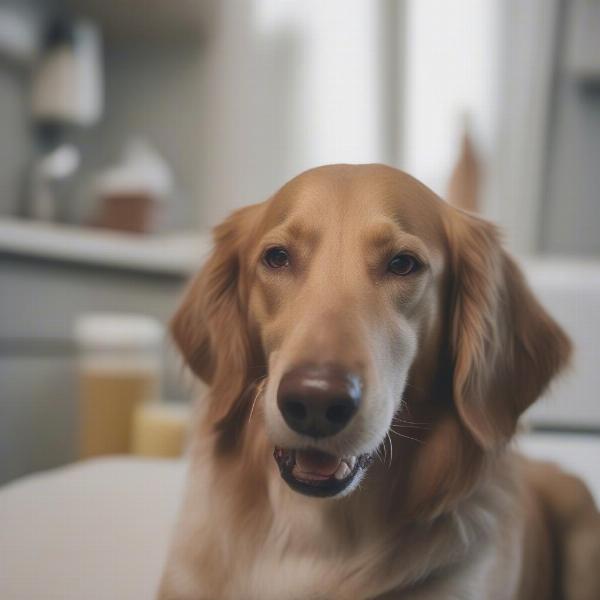Dog teeth pulled. These three words can bring a wave of worry to any dog owner. Whether your furry friend is facing a scheduled extraction or an emergency procedure, understanding the reasons behind it, the process involved, and the aftercare required can significantly ease your anxieties. This guide will delve into all aspects of canine tooth extraction, providing you with the knowledge and resources to navigate this challenging time with confidence.
Why Are Dog Teeth Pulled?
Several reasons can lead to the necessity of dog teeth pulled. These include severe periodontal disease (gum disease), fractured teeth, abscessed teeth, retained baby teeth, and sometimes, even for orthodontic reasons. Periodontal disease, a common ailment in dogs, can cause significant pain and infection if left untreated. Fractured teeth, often resulting from chewing on hard objects, can expose the sensitive pulp and lead to painful infections. Similarly, abscessed teeth, characterized by pus-filled pockets around the tooth root, require prompt attention to prevent the infection from spreading. Retained baby teeth, which fail to fall out naturally, can overcrowd the mouth and lead to misalignment of permanent teeth, necessitating their removal.
The Dog Teeth Pulled Procedure
The process of dog teeth pulled usually involves a pre-operative examination, anesthesia, the extraction itself, and post-operative care. During the pre-operative examination, the veterinarian will assess your dog’s overall health, perform blood work, and take dental X-rays to determine the extent of the dental issue. Anesthesia is essential for pain management and to keep your dog still during the procedure. The actual extraction may involve simple removal or more complex surgical techniques, depending on the tooth’s condition and location. After the extraction, your veterinarian will provide detailed instructions on pain management, feeding, and oral hygiene.
Aftercare for Dog Teeth Pulled
Post-operative care plays a vital role in your dog’s recovery after having their teeth pulled. Pain management is crucial, and your veterinarian will prescribe appropriate medications to keep your dog comfortable. Soft food is recommended for several days, gradually transitioning back to regular kibble as healing progresses. Maintaining oral hygiene is also essential, though it should be done gently to avoid irritating the extraction site. Your veterinarian will provide specific instructions on how to clean your dog’s mouth during the recovery period. Regular follow-up appointments are crucial to monitor healing and address any potential complications. dog teeth removal  Dog Teeth Pulled Aftercare
Dog Teeth Pulled Aftercare
Cost of Dog Teeth Pulled
The cost of dog teeth pulled varies depending on several factors, including the complexity of the extraction, the number of teeth being removed, the geographic location, and the veterinarian’s fees. Simple extractions are typically less expensive than complex surgical extractions. cost for dog tooth extraction It’s important to discuss the costs with your veterinarian beforehand and explore any available pet insurance options to help manage the financial burden. dog dental cleaning without anesthesia dog has 20 teeth pulled
Conclusion
Having your dog’s teeth pulled can be a stressful experience, but understanding the reasons, the procedure, and the aftercare can significantly alleviate your concerns. By working closely with your veterinarian and following their instructions diligently, you can ensure a smooth recovery for your furry companion. Regular dental check-ups and preventative care are crucial for maintaining your dog’s oral health and minimizing the need for extractions in the future.
FAQ
- How long does it take for a dog to recover after having a tooth pulled? Most dogs recover within a few days, but complete healing can take several weeks.
- Can my dog eat after having a tooth pulled? Yes, but only soft food should be offered initially.
- What are the signs of infection after a tooth extraction? Signs of infection include swelling, redness, discharge, and bad breath.
- Is it normal for my dog to be sleepy after having a tooth pulled? Yes, drowsiness is a common side effect of anesthesia.
- How can I prevent my dog from needing teeth pulled in the future? Regular brushing, dental chews, and professional cleanings can help maintain good oral health.
- What happens if a broken dog tooth is left untreated? It can lead to painful infections and potentially more serious health issues.
- Are there any alternatives to pulling a dog’s tooth? In some cases, root canal therapy or other dental procedures may be options.
About ILM Dog
ILM Dog (https://ilmdog.com) is a leading international online resource dedicated to providing expert advice on all aspects of dog care and wellbeing. We cover a wide range of topics, from breed selection and health to training, nutrition, grooming, and product recommendations. Our team of experienced writers and dog enthusiasts are passionate about helping dog owners provide the best possible care for their furry companions. Whether you’re a new dog owner or a seasoned pro, ILM Dog is your trusted source for practical, up-to-date information on everything dog-related. For any inquiries or assistance, please don’t hesitate to contact us via email at [email protected] or by phone at +44 20-3965-8624.